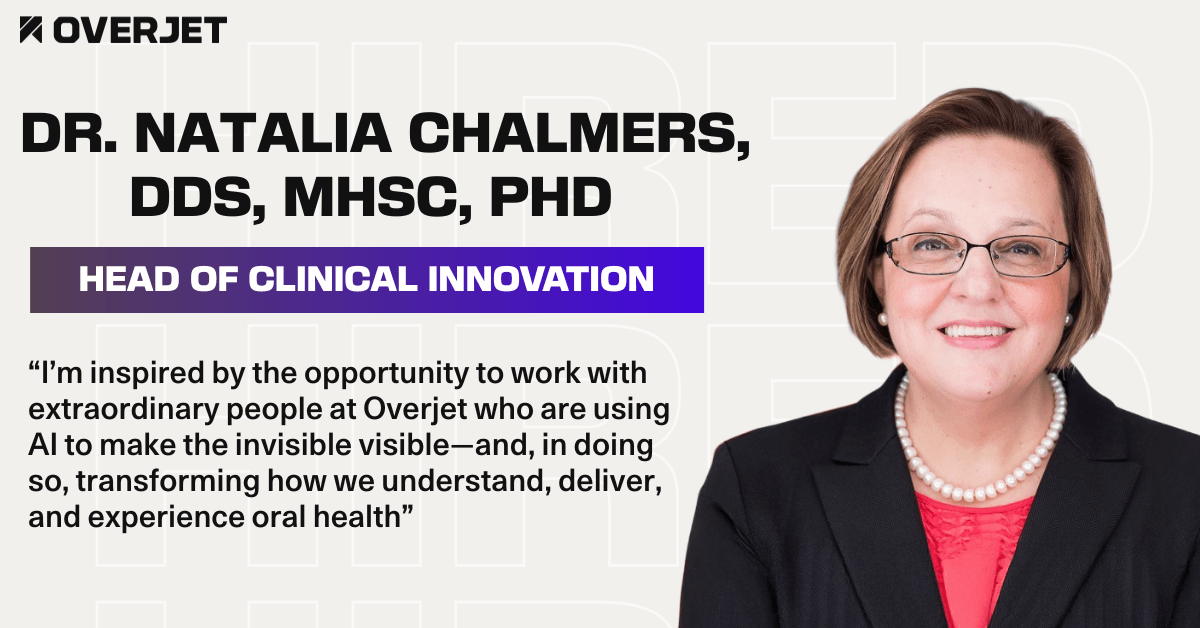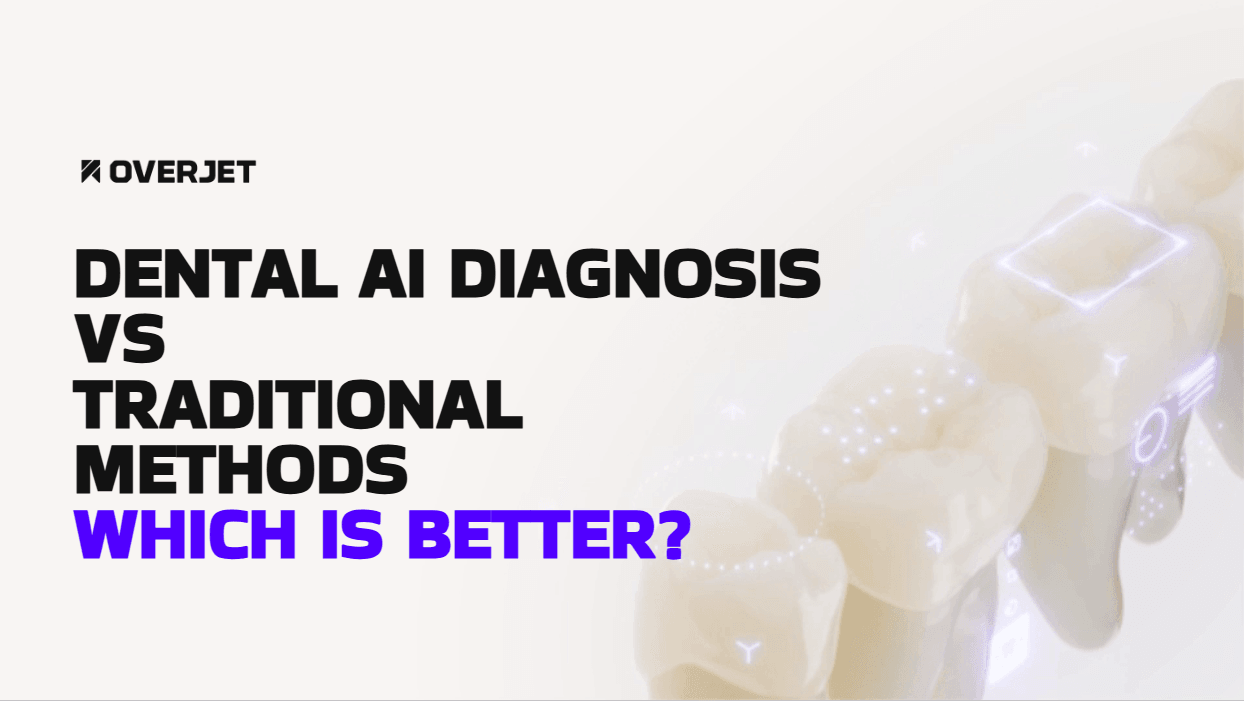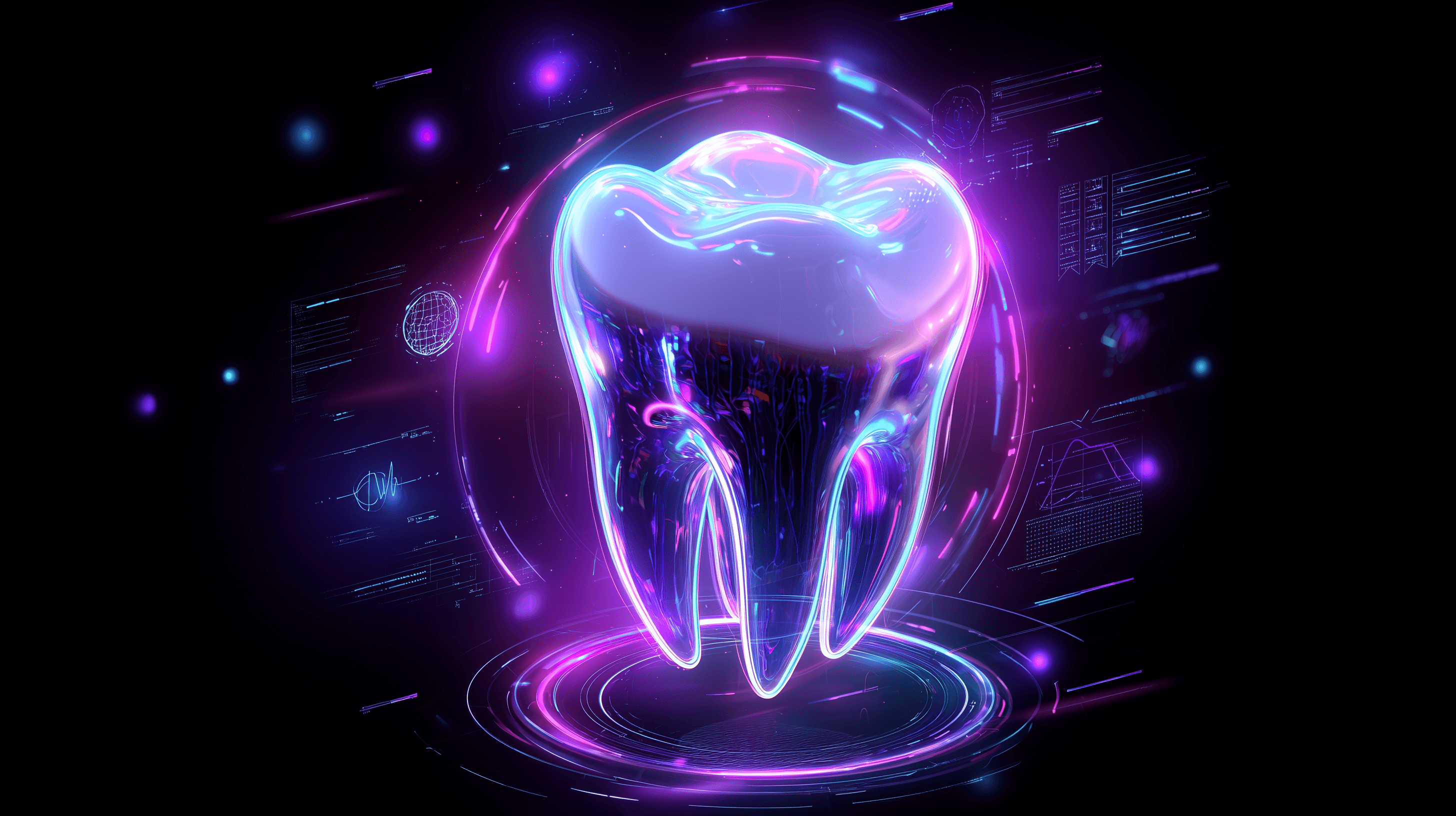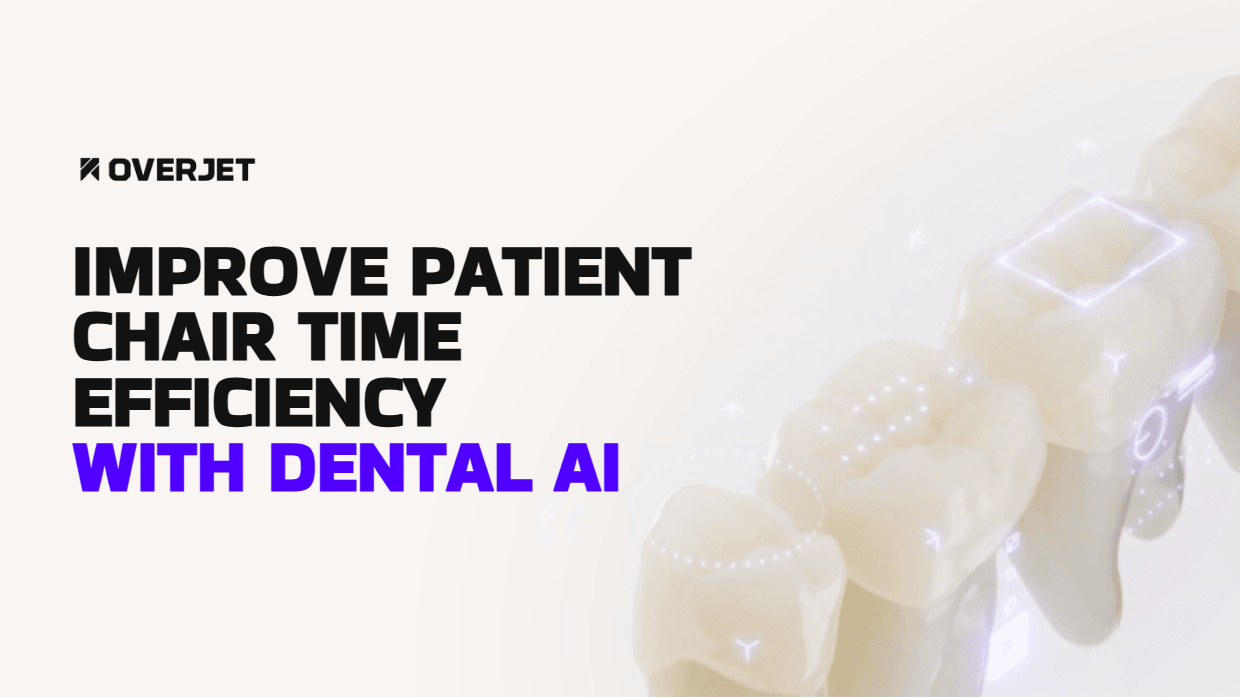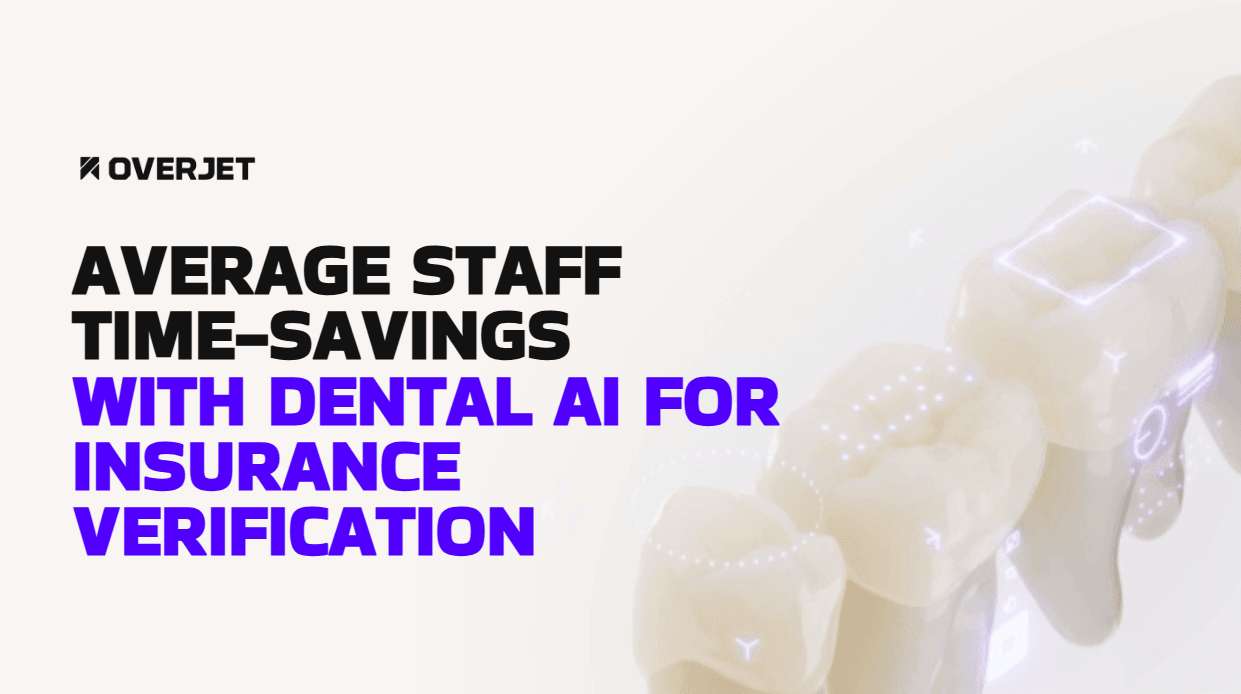Dental practices considering a platform switch face a common concern: will migration disrupt patient care, compromise historical data, or require weeks of downtime? The reality is that transitioning between dental AI systems involves manageable complexity when you understand the technical requirements, timeline expectations, and support structures that determine success.
This guide examines the complete migration process, from initial assessment and data portability to integration requirements, staff training, and ROI calculations, so you can approach your platform transition with confidence and realistic expectations.
Explore Overjet's Dental AI Software
Migrating From One Dental AI Platform to Another
Migrating between dental AI platforms typically takes two to four weeks for most practices, though the complexity depends on how your current and future platforms handle data transfer. The process involves moving patient imaging data, diagnostic annotations, and integration settings from one system to another while maintaining clinical accuracy and workflow continuity. Working with a vendor experienced in dental transitions can reduce disruptions significantly.
The main challenge centers on preserving historical diagnostic information without losing clinical context. AI platforms use different algorithms and detection models, so a finding classified as “moderate decay” in one system might appear as a numerical severity score in another. This means your migration team must map data carefully between systems to maintain diagnostic consistency.
Data Schema Mismatches
Each AI platform organizes diagnostic data differently, creating compatibility issues during transfers. One vendor might identify 12 distinct pathology types while another recognizes 20, requiring careful translation of your historical findings.
Common incompatibilities include:
Detection categories: Platforms classify conditions using different taxonomies that don’t always align directly
Confidence scoring: Some systems use percentages while others use numerical ranges or categorical ratings
Anatomical notation: Tooth numbering and surface classifications may follow different standardization protocols
Legacy Imaging Formats
Older imaging file types can interfere with newer AI detection algorithms. JPEG compression artifacts, for example, affect subtle density variations that AI relies on to identify early caries or bone loss. Overjet accepts standard DICOM formats and works with practices to convert legacy imaging libraries into compatible file types.
Third-Party Integrations
Reconnecting your practice management system, imaging software, and insurance tools to a new AI platform adds complexity. Your new vendor’s compatibility with systems like Dentrix, Eaglesoft, or Open Dental determines whether migration involves simple connections or custom development work. Overjet maintains pre-built integrations with major practice management platforms, eliminating the need to manage multiple vendor relationships during transitions. Insurance payer connections deserve particular attention since any disruption to claim submission directly impacts revenue cycles.
Pre-Migration Assessment for Dental Practices
Before switching platforms, practices evaluate whether their current AI system’s limitations justify the migration effort. This assessment typically reveals specific pain points that a new platform needs to address.
Diagnostic Accuracy Gaps
Identifying when your current AI fails to meet clinical standards starts with tracking false positives and false negatives across common pathologies. You might notice instances where the AI missed obvious decay, flagged healthy tissue as pathological, or gave inconsistent readings on similar cases.
Performance indicators worth reviewing:
Case acceptance rates when using AI-assisted diagnosis versus manual diagnosis
Frequency of overriding AI recommendations during treatment planning
Patient complaints about unnecessary procedures or missed conditions
Support and SLA Limitations
Common support issues that trigger platform switches include slow response times to technical problems and inadequate training resources for new staff. If your current vendor takes 48 hours or more to resolve integration failures, you’re experiencing productivity losses that accumulate over time. A system outage on a busy Monday morning can disrupt dozens of patient appointments and create cascading scheduling problems.
Future Feature Roadmap
A platform’s development trajectory helps predict whether it will meet your practice’s evolving needs over the next three to five years. Vendors that haven’t released meaningful updates in over 12 months may leave your practice with an increasingly outdated tool. Overjet continuously expands its FDA-cleared detection algorithms and releases workflow enhancements based on direct feedback from practicing dentists and DSO operations teams.
Data Portability and Ownership
Retaining complete access to historical patient data during platform transitions represents one of the most critical aspects of migration planning. Some vendors create barriers to data export through technical limitations or contractual restrictions.
DICOM Exports and Overlays
DICOM (Digital Imaging and Communications in Medicine) serves as the international standard for medical imaging data, including dental radiographs and their associated metadata. When AI platforms store diagnostic annotations as DICOM overlays, findings can transfer between systems without losing clinical context. However, proprietary annotation formats may render your historical AI findings inaccessible once you switch vendors. Overjet adheres to DICOM standards and provides export tools that preserve both raw imaging data and AI-generated annotations in universally compatible formats.
Annotation Metadata Transfer
Diagnostic annotations include more than just highlighted areas on radiographs. The data encompasses detection confidence scores, measurement data, temporal progression tracking, and treatment recommendation histories.
Components requiring careful migration:
Severity classifications and staging information
Date stamps showing disease progression over multiple visits
Clinician notes and modifications to AI suggestions
Claim Review Histories
Preserving insurance claim documentation helps maintain consistent reimbursement rates after switching platforms. Your historical claim data reveals which documentation approaches successfully justify procedures to specific payers and which trigger denials. Practices that lose access to this information often experience temporary increases in claim denial rates while they rebuild their understanding of payer preferences.
Technical Requirements for Seamless AI Integration
Infrastructure prerequisites significantly influence migration complexity and success rates. Practices that address technical requirements proactively experience fewer implementation delays.
Practice Management Compatibility
Integration complexity varies based on your existing practice management system and the new AI platform’s connector maturity. Established systems like Dentrix and Eaglesoft typically offer well-documented APIs that simplify integration, while smaller or regional vendors may require custom development work.
Practice Management System | Integration Complexity | Average Setup Time |
Dentrix, Eaglesoft, Open Dental | Low - Pre-built connectors | 1-2 days |
Curve, tab32, Denticon | Moderate - Standard APIs | 3-5 days |
Regional or custom systems | High - Custom development | 2-4 weeks |
Overjet maintains certified integrations with all major practice management platforms, ensuring that patient demographics, appointment schedules, and treatment plans synchronize automatically.
Cloud Bandwidth and Storage
AI processing and high-resolution image uploads demand robust network infrastructure. A single full-mouth series can generate 50-100MB of imaging data, and practices capturing 20-30 patients daily accumulate substantial bandwidth requirements quickly. Minimum specifications for smooth operation include 100 Mbps download speeds and 20 Mbps upload speeds, though practices with multiple operatories benefit from symmetrical gigabit connections.
API and Webhook Availability
APIs (Application Programming Interfaces) enable different software systems to exchange data automatically, while webhooks trigger actions in one system based on events in another. APIs function as standardized connectors that allow your AI platform to communicate with your practice management system without human intervention. When Overjet detects a condition requiring immediate attention, webhooks can automatically flag the patient chart and trigger follow-up appointment scheduling prompts.
Step-By-Step Migration Timeline and Resources
Realistic timeline expectations and proper resource allocation separate successful migrations from prolonged implementations that disrupt practice operations.
1. Discovery and Scoping
The initial assessment phase typically spans one to two weeks and involves cataloging your current data volume, integration requirements, and workflow customizations. During discovery, your new vendor’s implementation team examines your existing AI platform’s configuration and identifies potential migration obstacles. Overjet’s discovery process includes workflow observation sessions where implementation specialists watch your team use the current system to understand exactly how AI fits into your clinical and administrative processes.
2. Data Extraction and Validation
Data export procedures begin with extracting complete patient imaging libraries, diagnostic annotations, and treatment histories from your current platform. This phase typically requires three to five days for small practices and two to three weeks for large DSOs with multiple locations. Quality assurance checkpoints verify patient record completeness, confirm that all imaging files transferred without corruption, and validate that diagnostic annotations map correctly to the new platform’s taxonomy.
3. Parallel Run and QA
Running old and new systems simultaneously for one to two weeks provides confidence that the new platform produces clinically accurate results before full cutover. During this parallel period, your team processes actual patient cases through both systems and compares diagnostic outputs to identify concerning discrepancies. Quality assurance protocols focus on high-stakes scenarios like complex restorative cases, periodontal disease staging, and caries detection in challenging anatomical areas.
4. Go-Live and Post-Cut-Over Support
Final transition steps involve deactivating your old platform, confirming that all integrations function correctly under production load, and providing real-time support as your team encounters their first edge cases. Most practices schedule go-live for Monday morning to maximize available support time during the critical first week. Overjet assigns dedicated success engineers who remain closely engaged for 30 days post-migration, conducting weekly check-ins to address emerging questions and optimize workflows based on observed usage patterns.
Training and Change Management Strategies
Staff members who feel unprepared or skeptical about the new system will find workarounds that undermine intended workflow improvements. Engaged teams that understand the reasoning behind the change become powerful adoption advocates.
Role-Based Training Paths
Different staff members need different training depth based on their daily responsibilities. Dentists require deep clinical training on diagnostic interpretation and treatment planning features, while front desk staff need focused instruction on patient education tools.
Dentists and specialists: 2-3 hours on diagnostic accuracy, annotation tools, and clinical decision support
Hygienists: 1-2 hours on patient education visualizations and periodontal assessment workflows
Administrative staff: 1-2 hours on insurance claim documentation and patient communication tools
Champion User Program
Identifying one to two enthusiastic early adopters within your practice creates peer-led momentum that formal training sessions alone cannot achieve. Champion users become the go-to resources for quick questions and workflow tips, reducing dependency on vendor support for routine inquiries. These advocates typically emerge naturally during training sessions, they are the staff members asking detailed questions, exploring advanced features, and expressing genuine excitement about the platform’s capabilities.
Feedback Loops and Metrics
Collecting user feedback through structured channels like weekly team meetings or anonymous surveys helps identify friction points before they become permanent workarounds. Track both quantitative metrics (login frequency, feature utilization rates, time-per-task) and qualitative feedback about user satisfaction. Early warning signs of adoption problems include declining system usage after the first two weeks or staff members completing tasks manually that the AI platform handles automatically.
Calculating ROI When Switching Platforms
Cost-benefit analysis for platform migration extends beyond simple subscription fee comparisons to encompass implementation costs, productivity impacts, and long-term value creation.
License and Migration Fees
Typical costs include monthly or annual software licenses ranging from $200-800 per provider, one-time implementation fees from $2,000-10,000 depending on practice size, and training expenses that may involve temporary productivity reductions. Some vendors charge separate fees for data migration services, while others include comprehensive onboarding support in standard pricing. Exit fees from your current vendor deserve careful scrutiny since some contracts impose substantial penalties for early termination.
Efficiency Gains in Diagnostics
Improved AI accuracy reduces the time dentists spend analyzing radiographs and formulating treatment plans, creating capacity for additional patient appointments. These efficiency gains translate directly to revenue opportunities. A dentist who saves five minutes per patient examination can see two to three additional patients daily.
Faster Claim Approvals
Better AI documentation accelerates insurance processing by providing the detailed clinical evidence that payers require to approve treatments without requesting additional information. When claims include AI-annotated radiographs showing clear pathology with severity measurements, insurance reviewers can make approval decisions immediately rather than initiating time-consuming peer review processes.
Common Migration Pitfalls and How to Avoid Them
Frequent mistakes in platform transitions typically stem from inadequate planning, unrealistic expectations, or insufficient attention to change management.
Incomplete Data Mapping
Poor data migration planning results in lost clinical information, broken cross-references between patient records and imaging files, or diagnostic annotations that don’t align with their corresponding radiographs. Best practices for comprehensive data mapping include creating detailed inventories of all data types before extraction begins, defining explicit transformation rules for how old data structures convert to new formats, and conducting sample migrations on test data before processing your complete patient database.
Underestimating Downtime
Realistic expectations for system unavailability help practices plan appropriate contingencies. While vendors often promise zero-downtime migrations, the reality involves periods where certain features remain unavailable or perform slowly as data synchronization completes. Most practices experience four to eight hours of reduced functionality during cutover weekends, though complex migrations at large DSOs may require 24-48 hours for complete stabilization.
Ignoring Staff Adoption
Resistance to change and inadequate communication strategies undermine otherwise technically successful implementations. Staff members who don’t understand why the practice is switching platforms or how the new system benefits their daily work will passively resist adoption through minimal engagement. Effective communication begins weeks before migration with clear explanations of current platform limitations and specific improvements the new system provides.
What Sets Overjet Apart in Migration Support
Overjet’s approach to platform migration emphasizes comprehensive support, minimal practice disruption, and long-term partnership rather than transactional vendor relationships that end once technical implementation completes. The data migration service includes end-to-end responsibility for extracting, transforming, validating, and loading your complete patient database and imaging library. Implementation specialists handle all technical complexities while keeping practice administrators informed through regular progress updates.
Quality assurance processes involve multi-stage validation checks that compare source and destination data at the record, field, and file levels to ensure nothing gets lost or corrupted during transfer. Overjet minimizes practice disruption through phased implementation approaches that maintain operational continuity throughout the transition period. Rather than attempting risky big-bang cutovers, implementations proceed location-by-location for multi-site DSOs or operatory-by-operatory for larger single practices.
Personalized support extends far beyond initial go-live, with dedicated success engineers who learn your practice’s unique workflows, clinical preferences, and business objectives. Success engineers conduct quarterly business reviews examining key performance indicators like diagnostic accuracy metrics, case acceptance rates, and claim approval times while identifying opportunities to extract additional value from the platform.
Future-Proof Your Practice With Overjet’s Dental AI
Switching dental AI platforms represents a significant investment of time and resources, yet partnering with the right vendor transforms this challenge into an opportunity for substantial practice improvement. Overjet’s comprehensive migration support, proven track record with thousands of successful implementations, and commitment to ongoing innovation position practices for long-term success. The platform’s FDA-cleared diagnostic algorithms, seamless practice management integrations, and robust insurance claim automation deliver immediate operational benefits while establishing a foundation for future capabilities as AI technology continues advancing.
Ready to See Overjet's Dental AI in Action?
Frequently Asked Questions (FAQs)
What is dental practice software and why is AI important?
Dental practice software helps manage key areas like scheduling, billing, imaging, and patient records. With AI integration, these tools go further, automating radiograph analysis, improving diagnostic accuracy, and reducing administrative workload. AI makes the software smarter, faster, and more effective.
How does AI improve radiograph interpretation?
AI is trained on millions of dental images and can detect signs of caries, bone loss, and other conditions with precision. This supports more accurate diagnoses, faster treatment planning, and helps dentists maintain consistent standards across providers.
Can AI really reduce claim denials and boost revenue?
Yes. AI can verify insurance eligibility in real time, help document procedures more accurately, and flag potential coding errors. This leads to cleaner claims, fewer denials, and faster reimbursements, ultimately improving financial performance.
Is AI difficult to implement in a dental practice?
Not with the right support. Platforms like Overjet offer expert onboarding and training, helping practices start with high-impact features like radiograph analysis. The transition is designed to be smooth and non-disruptive to your daily workflow.
Why choose Overjet over other dental AI platforms?
Overjet is the only dental AI company with FDA clearance for detecting both caries and bone loss. It’s trusted by leading DSOs and private practices, integrates with existing systems, and delivers measurable improvements in clinical and financial outcomes.




